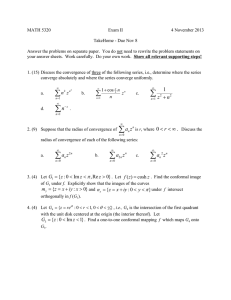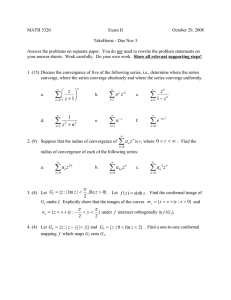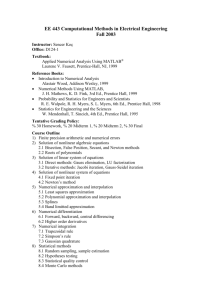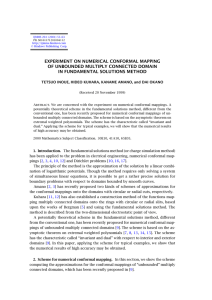Internat. J. Math. & Math. Sci. S0161171200002416 © Hindawi Publishing Corp.
advertisement
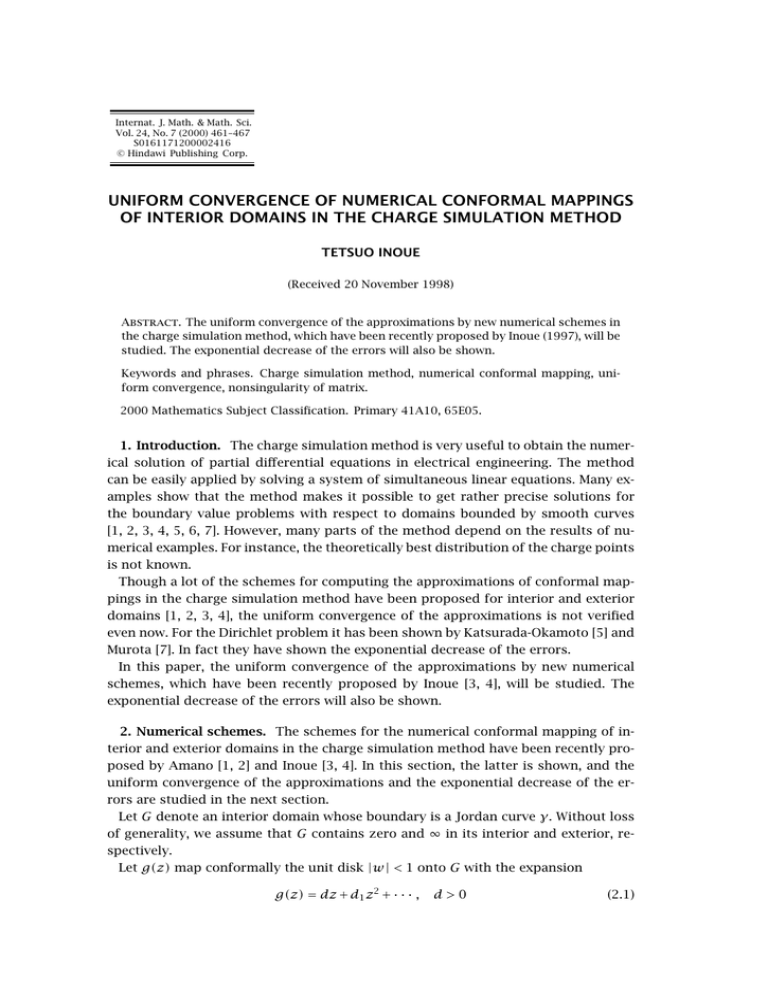
Internat. J. Math. & Math. Sci.
Vol. 24, No. 7 (2000) 461–467
S0161171200002416
© Hindawi Publishing Corp.
UNIFORM CONVERGENCE OF NUMERICAL CONFORMAL MAPPINGS
OF INTERIOR DOMAINS IN THE CHARGE SIMULATION METHOD
TETSUO INOUE
(Received 20 November 1998)
Abstract. The uniform convergence of the approximations by new numerical schemes in
the charge simulation method, which have been recently proposed by Inoue (1997), will be
studied. The exponential decrease of the errors will also be shown.
Keywords and phrases. Charge simulation method, numerical conformal mapping, uniform convergence, nonsingularity of matrix.
2000 Mathematics Subject Classification. Primary 41A10, 65E05.
1. Introduction. The charge simulation method is very useful to obtain the numerical solution of partial differential equations in electrical engineering. The method
can be easily applied by solving a system of simultaneous linear equations. Many examples show that the method makes it possible to get rather precise solutions for
the boundary value problems with respect to domains bounded by smooth curves
[1, 2, 3, 4, 5, 6, 7]. However, many parts of the method depend on the results of numerical examples. For instance, the theoretically best distribution of the charge points
is not known.
Though a lot of the schemes for computing the approximations of conformal mappings in the charge simulation method have been proposed for interior and exterior
domains [1, 2, 3, 4], the uniform convergence of the approximations is not verified
even now. For the Dirichlet problem it has been shown by Katsurada-Okamoto [5] and
Murota [7]. In fact they have shown the exponential decrease of the errors.
In this paper, the uniform convergence of the approximations by new numerical
schemes, which have been recently proposed by Inoue [3, 4], will be studied. The
exponential decrease of the errors will also be shown.
2. Numerical schemes. The schemes for the numerical conformal mapping of interior and exterior domains in the charge simulation method have been recently proposed by Amano [1, 2] and Inoue [3, 4]. In this section, the latter is shown, and the
uniform convergence of the approximations and the exponential decrease of the errors are studied in the next section.
Let G denote an interior domain whose boundary is a Jordan curve γ. Without loss
of generality, we assume that G contains zero and ∞ in its interior and exterior, respectively.
Let g(z) map conformally the unit disk |w| < 1 onto G with the expansion
g(z) = dz + d1 z2 + · · · ,
d>0
(2.1)
462
TETSUO INOUE
near z = 0. Then the following scheme for computing an approximation of g(z) has
been recently proposed in [3, 4].
Scheme 2.1. The approximation gn (z) of g(z) may be obtained as follows:
n
(2a) {zn,i }n
i=1 and {ζn,i }i=1 (called charge points and collocation points) are chosen
on |z| = ρ and on |z| = 1, respectively, so that
2π (i − 1)
.
ρ > 1, θi =
n
zn,i = ρζn,i ,
ζn,i = e
iθi
(2.2)
(2b) When αi (i = 0, 1, 2, . . . , n) are the solutions of a system of simultaneous linear
equations
α0 + log |ζn,k | +
n
i=1
ζn,k = log g ζn,k (k = 1, 2, . . . , n),
αi log 1 −
zn,i
(2.3)
α1 + α2 + · · · + αn = −1,
n
the charges at {zn,i }n
i=1 are given by {αi }i=1 .
(2c) The approximation gn (z) is represented by
gn (z) = e
α0
n
z
z exp
αi log 1 −
z
n,i
i=1
.
(2.4)
We have, in Scheme 2.1, assumed that the values log |g(ζn,k )| (k = 1, 2, . . . , n) are
known. It is known that the scheme (2.4) has the following mathematical properties.
(2d) The constant terms of schemes have a geometric meaning. The constant term
in (2.4) has the approximations of high accuracy
α0 log d,
(2.5)
when the charge and collocation points are suitably distributed [3, 4].
(2e) The schemes are dual with respect to interior and exterior mappings. This means
that there hold (2.4) with (2.3) and
fn (z) = e
α0
n
zn,i
z exp
αi log 1 −
z
i=1
(2.6)
with
α 1 + α2 + · · · + α n = 1
(2.7)
for interior and exterior domains, respectively.
(2f) The scheme (2.4) introduced in this paper has the invariant property (whose
definition is shown in the next section) under any scaling of domains.
Invariant schemes analogous to ours have recently been proposed for the mapping
from a general domain onto a standard one [2]. However they do not have the dual
property.
UNIFORM CONVERGENCE OF NUMERICAL CONFORMAL MAPPINGS . . .
463
3. Murota scheme. Let h(z) de a harmonic function on the closed unit disk |w| ≤
1. Murota [6] has recently proposed the following scheme of approximations in the
Dirichlet problem.
Scheme 3.1. The approximation hn (z) of h(z) may be obtained as follows:
n
(3a) The charge points {zn,i }n
i=1 and the collocation points {ζn,i }i=1 are chosen on
|z| = ρ (ρ > 1) and on |z| = 1, respectively, by the method same as (2a).
(3b) When αi (i = 0, 1, 2, . . . , n) are the solutions of a system of simultaneous linear
equations
β0 +
n
βi log |ζn,k − zn,i | = h ζn,k
(k = 1, 2, . . . , n),
(3.1)
i=1
β1 + β2 + · · · + βn = 0,
(3.2)
n
the charges at {zn,i }n
i=1 are given by {βi }i=1 .
(3c) The approximation hn (z) is represented by
hn (z) = β0 +
n
βi log |z − zn,i |.
(3.3)
i=1
The approximation is superior in the sense that it remains invariant with respect
to trivial affine transformations. More precisely, Murota-scheme has the advantage
satisfying the following “invariant” property.
z → az,
zn,i → azn,i ,
h(z) → h(z) + b
(3.4)
implies
hn (z) → hn (az),
hn (z) → hn (z) + b,
(3.5)
where a(= 0) and b are constant. Using the sub-condition (3.2), the invariant property
is easily verified.
We may show that the scheme (2.4) introduced in this paper has the invariant property mentioned above without any sub-condition, but
eα0 → aeα0 .
(3.6)
When the charge points and the collocation points are distributed as (2a), (3.1) with
(3.2) is transformed to
hn (z) = β0 +
z βi log 1 − z n,i
i=1
n
(3.7)
with
β1 + β2 + · · · + βn = 0.
(3.8)
Under the condition that the function h(z) may have a conformally extension, the
following (3d) and (3e) have been verified by Murota [7].
464
TETSUO INOUE
(3d) The coefficient matrix in Scheme 3.1 is nonsingular.
(3e) There exist positive constants c, 0 < τ < 1 and n0 such that
hn (z) − h(z) ≤ cτ n ,
∀n ≥ n0 ,
(3.9)
where c depends on ρ.
4. Uniform convergence. Under the condition that the function may have a conformally extension, the following (4a) and (4b) will be shown in this section.
(4a) The coefficient matrix in Scheme 2.1 is nonsingular.
(4b) There exist positive constants c, 0 < τ < 1 and n0 such that
gn (z) − g(z) ≤ cτ n ,
∀n ≥ n0 , |z| ≤ 1,
(4.1)
where c depends on ρ.
(4a) and (4b) for the approximations gn (z) may be shown from (3d) and (3e), and
the fact that the uniform convergence of real parts of regular functions implies the
one of the imaginal.
Since the coefficient matrices in Schemes 2.1 and 3.1 are same, (4a) is trivial. Next
the uniform convergence of the approximations gn (z), obtained by the Scheme 2.1,
will be shown as follows.
Equation (2.3) may be transformed to (3.2) and (3.3), respectively, where
g(z) z ,
1−
(4.2)
h(z) = log z
z1 β 0 = α0 ,
β1 = α1 + 1,
βk = α k
(k = 1, 2, . . . , n).
The approximation hn (z) has the form (3.7) with (3.8). When
g (z) z n
1−
hn (z) = log z
z1 (4.3)
(4.4)
with (4.3), gn (z) is represented as (2.4) with (2.3).
Now we consider a function
Gn (z) =
gn (z)
g(z)
(4.5)
analytic on the disk |z| < ρ with the expansion
Gn (z) =
e0α
+ c1 z + · · ·
d
(4.6)
near z = 0.
Then using (3.9), (4.2), (4.4), and (4.5) there holds
| log |Gn (z)| | = | log |gn (z)| − log |g(z)| | = | log |hn (z)| − log |h(z)| | ≤ cτ n .
(4.7)
Since Gn (0) = eα0 /d, log Gn (z) is represented as follows (using the representation
has been supported by an unknown researcher).
UNIFORM CONVERGENCE OF NUMERICAL CONFORMAL MAPPINGS . . .
log Gn (z) = log gn (z) − log g(z)
ρ eiθ + z
1 2π
=
dθ
log Gn ρ eiθ iθ
2π 0
ρ e −z
ρ +1
ρ =
,
2
465
(4.8)
which implies for |z| ≤ 1 that
n
log Gn (z) = log gn (z) − log g(z) ≤ cτ ρ + 1 .
ρ − 1
(4.9)
Therefore there exist positive constants c2 , 0 < τ < 1,
gn (z) − g(z) ≤ c2 τ n ,
∀n ≥ n0 , |z| ≤ 1,
(4.10)
where c2 depends on ρ.
Thus the uniform convergence of the approximations gn (z), obtained by Scheme
2.1, has been verified.
5. Example. The object of this section is to estimate the exponential decrease of
the errors in Scheme 2.1 by an example. We consider the function
w = g(z) =
4z
4 − z2
(5.1)
which maps conformally the unit disk |z| < 1 onto a domain G denoted in Figure 5.1.
1.0
0.5
−2
−1
0.0
−0.5
1
0
2
−1.0
Figure 5.1. The domain G.
Example 5.1. We distribute the charge points and collocation points as (2.2). We
solve a system of simultaneous linear equations (2.3) with ρ = 2, 9 ≤ n ≤ 42 and
obtain the charges {αi }n
i=1 .
Using the charges, the approximation (2.4) is represented. Accuracy of the errors of
gn (z) is estimated by the maximum E(n) of
gn ζ100,i − g ζ100,i (i = 1, 2, . . . , 100).
(5.2)
By the maximum principle for the regular functions, it is sufficient that the errors are
estimated only on the boundary. The graphs log E(n) are shown in Figures 5.2 and 5.3
for even and odd n, respectively.
466
TETSUO INOUE
101
10−2
10−5
0
20
40
60
10−8
10−11
10−14
Figure 5.2. Graph for even n.
101
10−1
10
0
20
40
60
−3
10−5
10−7
Figure 5.3. Graph for odd n.
The numerical calculation has been performed in MsDevf90 (PC98XA21-NEC) and
with double precision.
6. Concluding remarks. We have assumed that the values g(z) at collocation
points are known. Otherwise at first consider the inverse function z = g −1 (w) of
w = g(z). Then |g −1 (w)| = 1 holds on the boundary of G. Applying the charge simulation method for z = g −1 (w), the approximation of g −1 (w) will be utilized instead
of the real values at the collocation points.
References
[1]
[2]
[3]
[4]
[5]
K. Amano, A charge simulation method for the numerical conformal mapping of interior,
exterior and doubly-connected domains, J. Comput. Appl. Math. 53 (1994), no. 3,
353–370. MR 95i:30007. Zbl 818.30004.
K. Amano and T. Inoue, Dilation invarience of the numerical conformal mapping in the
charge simulation method, Trans. Japan Soc. Indust. and Appl. Math. 8 (1998), 1–17
(Japanese).
T. Inoue, Algorithm for computing an inverse function of a conformal mapping by fundamental solution method, Trans. Inform. Process. Soc. Japan 38 (1997), no. 2, 377–379.
MR 97m:30005.
T. Inoue and K. Amano, Numerical study based on theoretical distributions of charge points
in charge simulation method for numerical conformal mappings, Trans. Japan Soc.
Indust. and Appl. Math. 7 (1997), 429–442 (Japanese).
M. Katsurada and H. Okamoto, The collocation points of the fundamental solution
method for the potential problem, Comput. Math. Appl. 31 (1996), no. 1, 123–137.
CMP 1 362 387. Zbl 852.65101.
UNIFORM CONVERGENCE OF NUMERICAL CONFORMAL MAPPINGS . . .
[6]
[7]
467
S. Murasima, Charge Simulation Method and its Application, Morikita Syuppan, Tokyo,
1993 (Japanese).
K. Murota, On “invariance” of schemes in the fundamental solution method, Trans. Inform.
Process. Soc. Japan 3 (1993), 533–535 (Japanese).
Tetsuo Inoue: Department of Applied Mathematics, Kobe Mercantile Marine College,
Higashinada, Fukae-Minami 5-1-1, Kobe 658-0022, Japan
E-mail address: inoue-te@tiedu.kshosen.ac.jp
